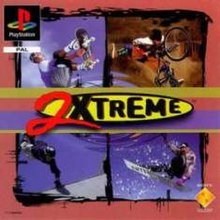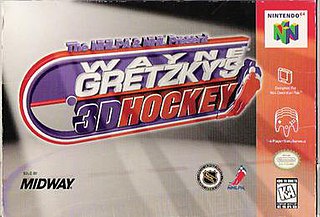
Wayne Gretzky's 3D Hockey is a video game developed and published by Atari Games for the arcade in 1996. A port for the Nintendo 64 console was released almost simultaneously with the arcade version, on November 15, 1996, making it the first-ever 4-player game for the Nintendo 64, beating Mario Kart's Japanese release by more than a month. The game was followed by a sequel, Wayne Gretzky's 3D Hockey '98.
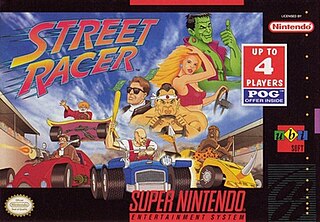
Street Racer is a racing video game published by Ubi Soft for various systems. It was released for the Super Nintendo Entertainment System in 1994, Sega Mega Drive in 1995, PlayStation, Sega Saturn and Game Boy in 1996 and PC and Amiga in 1997. Marketed as a "cross between Mario Kart and Street Fighter", the go-kart themed game combined racing with comedy and beat 'em up influenced violence. The game was a success on the SNES and Mega Drive and received mixed reviews across platforms.

ATV Offroad Fury is a 2001 racing video game developed by Rainbow Studios and published by Sony Computer Entertainment exclusively for the PlayStation 2 in North America and Europe.

Black Dawn is a helicopter-combat simulation, published by Virgin Interactive Entertainment. It was released on the Sony PlayStation and the Sega Saturn in 1996.

Viewpoint is an isometric-scrolling shooter arcade game developed by Aicom and originally released in 1992 by Sammy and SNK for the Neo Geo hardware family. The arcade version was met with critical acclaim upon release for its cutting-edge visuals and hip hop-influenced soundtrack, though later ports for the Sega Genesis and Sony PlayStation saw much more mixed reviews.

Cool Boarders is a snowboarding video game developed by UEP Systems for the PlayStation. It was released in Japan by UEP Systems in August 1996 and internationally by Sony Computer Entertainment in January 1997.

Motor Toon Grand Prix 2 (モータートゥーン・グランプリ2) is a 1996 kart racing video game developed and published by Sony Computer Entertainment for the PlayStation. It was released in the US as Motor Toon Grand Prix since its predecessor never left Japan. Polys would follow up this game with Gran Turismo and form Polyphony Digital following the game's success.

Bottom of the 9th is a baseball game by Konami for the PlayStation, which was later ported to the Sega Saturn and the Nintendo 64. It is a heavily updated version of Konami's 1989 arcade game Bottom of the Ninth. The game is part of Konami's XXL Sports brand.

NBA Hangtime is a 1996 basketball arcade game developed and released by Midway. Home versions were released for the Nintendo 64, PlayStation, Super NES, Sega Genesis, and Microsoft Windows.

Loaded is a science fiction-themed top-down multidirectional shooter developed by Gremlin Interactive. Loaded was released on December 15, 1995 on the PlayStation, and was ported to the Sega Saturn the following year. The game had origins in DC Comics as well as the more adult-orientated Vertigo Comics, and there was a small graphic novel based on the game. The six playable characters of the game are a combination of villains, anti-heroes, psychopaths, perverts, mutants, and flamboyant murderers. They are, however, the best hope to stop the intergalactic supervillain nicknamed F.U.B. and save the universe. The characters were created and designed with contributions from Garth Ennis of Vertigo Comics and Greg Staples of 2000AD.

Madden NFL 97 is a football video game released in 1996. It was the first Madden game released for the PlayStation and Sega Saturn. 16-bit versions were also made for the established Super NES and Genesis platforms, as well as a portable version for the Game Boy.

ESPN Extreme Games is a game released for the PlayStation in 1995. A version was released for MS-DOS a short time later. The game featured all the sports included in the Summer X-Games of 1995, but it did not feature events such as the half pipe in skateboarding. It was similar to Road Rash, which was a game published by Electronic Arts. The game was followed by two sequels, 2Xtreme and 3Xtreme.

Off-World Interceptor is a 1994 third-person vehicular combat video game, developed and published by Crystal Dynamics and originally released on 3DO. An alternate version of the game was later released for the Sega Saturn and PlayStation consoles, named Off-World Interceptor Extreme. The two versions of the game have identical core gameplay elements, though the Extreme version is tweaked to feel more like the arcade mode in the original Off-World Interceptor.

BattleSport is a 1996 futuristic sports video game developed by Cyclone Studios. It was originally published by Studio 3DO exclusively for their 3DO Interactive Multiplayer in 1996, but after the 3DO was discontinued BattleSport was published for other systems by Acclaim Entertainment. It was released for Windows and PlayStation, Sega Saturn, and Windows in North America in July 1997, and in Europe on August 1, 1997.

3Xtreme is a 1999 racing video game developed and published by 989 Sports for the PlayStation. As with 2Xtreme, 3Xtreme contains skateboarding, skating, and cycling options to reach the goal before opponent players.
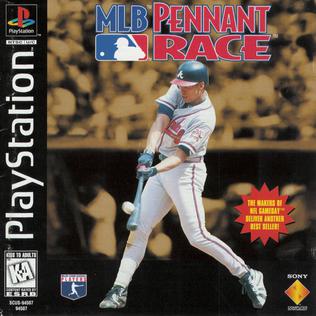
MLB Pennant Race is a baseball video game developed by Sony Interactive Studios America and published by Sony Computer Entertainment for the PlayStation. The game takes place during the 1996 Major League Baseball season; rosters and statistics are accurate as of the 1995 Major League Baseball season. The game was followed by the 989 Sports Major League Baseball series as well as the MLB: The Show franchise.
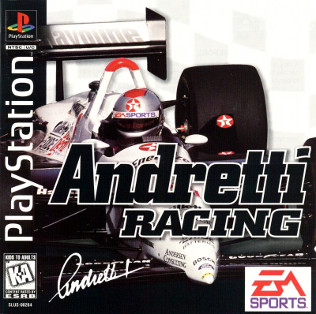
Andretti Racing is a video game developed by American studios High Score Productions and Stormfront Studios and published by EA Sports for the PlayStation and Sega Saturn in 1996, and for Windows in 1997. The game's title refers to legendary racing drivers Mario Andretti and Michael Andretti.

Goal Storm, known as World Soccer: Winning Eleven in Japan, is a football sports video game developed by Konami Computer Entertainment Tokyo and published by Konami. It was released in late 1995 in North America and in early 1996 elsewhere for the PlayStation. It is the first installment of the Winning Eleven franchise, later known as Pro Evolution Soccer internationally. Gameplay-wise, the player controls one of thirty six national teams over two different game modes, which both simulate association football matches and/or tournaments.

NHL FaceOff '97 is an ice hockey video game developed by Killer Game and published by Sony Computer Entertainment for the PlayStation. It is the second game in the NHL FaceOff series.
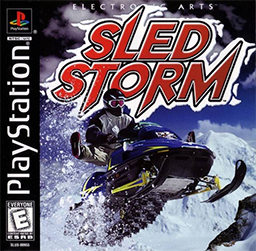
Sled Storm is a snowmobile racing video game published and developed by Electronic Arts. It gained critical acclaim due to its original concept of being one of the first snowmobile racing titles.
